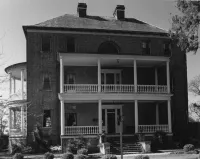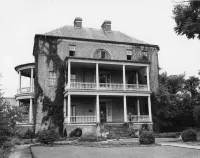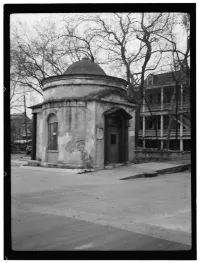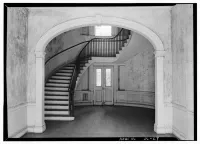Share what you know,
and discover more.
Share what you know,
and discover more.
Nov 07, 1973

-

- Charmaine Bantugan
National Register of Historic Places - Joseph Manigault House
Statement of Significant: One of the finest examples of the Adam style in America, the Joseph Manigault house reflects the architect's taste for the classic style. Particularly of note is the small and refined scale of the detail in mantels, door and window moldings, and cornices at wall and ceiling angles. Robert Adam was the first architect using this classic vocabulary to make a distinction between the scale of temples and the smaller scale appropriate to domestic architecture. Gabriel Manigault was aware of this distinction and exemplified it in this, his first neoclassic building. The house was designed, as above mentioned, by Gabriel Manigault for his brother, Joseph, and built in 1790; the designer Manigault had studied in Geneva and London before the Revolution and had begun to form his ideas concerning architecture there. He came back to Charleston shortly before the war and designed several buildings in the city after the war. Although Manigault designed only a few buildings in Charleston (five), the qualities of refinement, elegance, and varied spatial forms are so distinctive in the house that he contrived for his brother that his reputation will always rest secure. It is highly significant that in the city it was the first house to be planned de nouveau to suit the requirements of the owner instead of following the often-repeated plans of either the single house or the double house then so popular. (Albert Simons, FAIA) In the architectural survey of Charleston, a jury composed of Dr. William Murtagh, Keeper of the National Register of Historic Places, Professor Bernard Lemann, Tulane University School of Architecture, Mr. Carl Feiss and Mr. Russell Wright, consultants to the city, noted this structure as exceptional. This notation indicates that the building is of the highest architectural design quality, well-proportioned, and architecturally sophisticated. Windows, classical orders of other period designs, chimneys, verandahs, massing, materials, textures, refined detail, and craftsmanship are all elegant and innovative. The structure is to be preserved and protected in situ at all costs.
National Register of Historic Places - Joseph Manigault House
Statement of Significant: One of the finest examples of the Adam style in America, the Joseph Manigault house reflects the architect's taste for the classic style. Particularly of note is the small and refined scale of the detail in mantels, door and window moldings, and cornices at wall and ceiling angles. Robert Adam was the first architect using this classic vocabulary to make a distinction between the scale of temples and the smaller scale appropriate to domestic architecture. Gabriel Manigault was aware of this distinction and exemplified it in this, his first neoclassic building. The house was designed, as above mentioned, by Gabriel Manigault for his brother, Joseph, and built in 1790; the designer Manigault had studied in Geneva and London before the Revolution and had begun to form his ideas concerning architecture there. He came back to Charleston shortly before the war and designed several buildings in the city after the war. Although Manigault designed only a few buildings in Charleston (five), the qualities of refinement, elegance, and varied spatial forms are so distinctive in the house that he contrived for his brother that his reputation will always rest secure. It is highly significant that in the city it was the first house to be planned de nouveau to suit the requirements of the owner instead of following the often-repeated plans of either the single house or the double house then so popular. (Albert Simons, FAIA) In the architectural survey of Charleston, a jury composed of Dr. William Murtagh, Keeper of the National Register of Historic Places, Professor Bernard Lemann, Tulane University School of Architecture, Mr. Carl Feiss and Mr. Russell Wright, consultants to the city, noted this structure as exceptional. This notation indicates that the building is of the highest architectural design quality, well-proportioned, and architecturally sophisticated. Windows, classical orders of other period designs, chimneys, verandahs, massing, materials, textures, refined detail, and craftsmanship are all elegant and innovative. The structure is to be preserved and protected in situ at all costs.
Nov 07, 1973
National Register of Historic Places - Joseph Manigault House
Statement of Significant:One of the finest examples of the Adam style in America, the Joseph Manigault house reflects the architect's taste for the classic style. Particularly of note is the small and refined scale of the detail in mantels, door and window moldings, and cornices at wall and ceiling angles. Robert Adam was the first architect using this classic vocabulary to make a distinction between the scale of temples and the smaller scale appropriate to domestic architecture. Gabriel Manigault was aware of this distinction and exemplified it in this, his first neoclassic building.
The house was designed, as above mentioned, by Gabriel Manigault for his brother, Joseph, and built in 1790; the designer Manigault had studied in Geneva and London before the Revolution and had begun to form his ideas concerning architecture there. He came back to Charleston shortly before the war and designed several buildings in the city after the war.
Although Manigault designed only a few buildings in Charleston (five), the qualities of refinement, elegance, and varied spatial forms are so distinctive in the house that he contrived for his brother that his reputation will always rest secure. It is highly significant that in the city it was the first house to be planned de nouveau to suit the requirements of the owner instead of following the often-repeated plans of either the single house or the double house then so popular. (Albert Simons, FAIA)
In the architectural survey of Charleston, a jury composed of Dr. William Murtagh, Keeper of the National Register of Historic Places, Professor Bernard Lemann, Tulane University School of Architecture, Mr. Carl Feiss and Mr. Russell Wright, consultants to the city, noted this structure as exceptional. This notation indicates that the building is of the highest architectural design quality, well-proportioned, and architecturally sophisticated. Windows, classical orders of other period designs, chimneys, verandahs, massing, materials, textures, refined detail, and craftsmanship are all elegant and innovative. The structure is to be preserved and protected in situ at all costs.
Posted Date
Jun 09, 2023
Historical Record Date
Nov 07, 1973
Source Name
National Register of Historic Places
Source Website
Delete Story
Are you sure you want to delete this story?
Joseph Manigault House, Gatehouse, 350 Meeting St Charleston, Charleston County, SC
HABS SC-67-APosted Date
Sep 27, 2021
Source Name
Library of Congress
Source Website
Delete Story
Are you sure you want to delete this story?
Joseph Manigault House, 350 Meeting St & Ashmead Place, Charleston, Charleston County, SC
HABS SC-67Posted Date
Sep 27, 2021
Source Name
Library of Congress
Source Website
Delete Story
Are you sure you want to delete this story?














